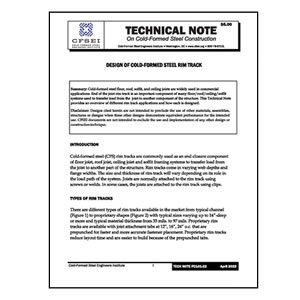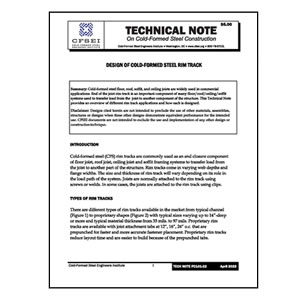Tech Note 558b-1: Lateral Load Resisting Elements: Diaphragm Design Values
$5.00
Archived with cover page Nov. 2011
Summary: This note was archived November, 2011. The author has developed ASD design tables using an analytical method for wood framing based on the provisions of the 1991 edition of the AFPA National Design Specification for Wood Construction. Additional research is needed to bring the data in line with current codes and standards. The data below is from commentary section D2.1 of American Iron and Steel Institute AISI 213, Standard for Cold-Formed Steel Framing – Lateral Design.
Disclaimer: Designs cited herein are not intended to preclude the use of other materials, assemblies, structures or designs when these other designs demonstrate equivalent performance for the intended use. CFSEI documents are not intended to exclude the use and implementation of any other design or construction technique.
Related Products

Tech Note F101-12: Screws for Cold-Formed Steel-To-Wood and Wood-To-Cold-Formed Steel Attachments
Summary: Screws are often used to attach cold-formed steel (CFS) framing to wood members or wood structural panel decking to CFS joists or rafters. The AISI North American Specification for the Design of Cold-Formed Steel Structural Members (AISI S100) provides design equations for screw connection capacity for CFS members. The National Design Specification for Wood Construction (NDS) provides design equations for fastener/connection capacity (nails, wood screws, bolts, etc.) in wood members. The Engineered Wood Association (APA) and the building codes offer several resources for determining the capacity of screw connections attaching wood sheathing. This Tech Note reviews these resources and discusses design and detailing of these fastener connections.
Disclaimer: Designs cited herein are not intended to preclude the use of other materials, assemblies, structures or designs when these other designs demonstrate equivalent performance for the intended use. CFSEI documents are not intended to exclude the use and implementation of any other design or construction technique.

Tech Note W105-21: Design of Nonstructural Members
Summary: The AISI S220, North American Standard for Cold-Formed Steel Nonstructural Framing was developed in 2011 to help clearly delineate and eliminate confusion between the requirements for cold-formed steel structural members and nonstructural members. This Technical Note is intended as an introduction to this standard and as an illustrative guide for applying the provisions to the design of nonstructural members.
This Technical Note updates and replaces CFSEI Technical Note W105-13
Disclaimer: Designs cited herein are not intended to preclude the use of other materials, assemblies, structures or designs when these other designs demonstrate equivalent performance for the intended use. CFSEI documents are not intended to exclude the use and implementation of any other design or construction technique.

Tech Note F102-21: Screw Fastener Selection For Cold-Formed Steel Frame Construction
This Technical Note updates and replaces CFSEI Tech Note F102-11
Summary: Specifying the proper fastener is necessary to assure the proper performance of the connections used in cold-formed steel construction. Cold-formed steel connections primarily utilize externally threaded fasteners, so embedment is not the controlling parameter. Instead, the design of the fastener along with the thickness of the steel govern the value of the connection. This Tech Note provides basic information for determining the appropriate screw type for various applications.
Disclaimer: Designs cited herein are not intended to preclude the use of other materials, assemblies, structures or designs when these other designs demonstrate equivalent performance for the intended use. CFSEI documents are not intended to exclude the use and implementation of any other design or construction technique.

Tech Note G105-22: Compression Member Reinforcement
Summary: To modify the capacity of a compression member, e.g. wall stud or truss web, adding a reinforcement may result in a non-prismatic member. This Tech Note provides guidance to evaluate the strength of a non-prismatic compression member.
Disclaimer: Designs cited herein are not intended to preclude the use of other materials, assemblies, structures or designs when these other designs demonstrate equivalent performance for the intended use. CFSEI documents are not intended to exclude the use and implementation of any other design or construction technique.

Tech Note B010-21: Introduction to AISI S202, Code of Standard Practice for Cold-Formed Steel Structural Framing
Summary: Understanding the responsibilities of the different parties involved in a cold-formed steel framing project can be confusing. This Technical Note is an introduction to AISI S202, Code of Standard Practice for Cold-Formed Steel Structural Framing published by the American Iron and Steel Institute (AISI).
Disclaimer: Designs cited herein are not intended to preclude the use of other materials, assemblies, structures or designs when these other designs demonstrate equivalent performance for the intended use. CFSEI documents are not intended to exclude the use and implementation of any other design or construction technique.

Tech Note W600-21: Cold-Formed Steel Load-Bearing Wall Design
Summary: This Technical Note has been written to help cold-formed steel (CFS) engineers further their understanding of structural load-bearing CFS walls. Given the myriad of details required for such structures, the importance of proper design and analysis of load-bearing CFS members cannot be understated. This Technical Note will discuss the various design considerations that must be taken into consideration during the design phase of such structures.
Disclaimer: Designs cited herein are not intended to preclude the use of other materials, assemblies, structures or designs when these other designs demonstrate equivalent performance for the intended use. CFSEI documents are not intended to exclude the use and implementation of any other design or construction technique.

Tech Note G200-21: Chase the Loads: Load Path Considerations for Cold-Formed Steel Light-Frame Construction
This Technical Note updates and replaces CFSEI Technical Note G200-15
Summary: Engineering students are admonished to “chase the loads” in their structural analysis and design courses. A “load path” is the direction in which each consecutive load will pass through framing members and the connected members of a framing assembly. The load path sequence begins at the point of load application, both vertical (gravity, wind uplift or seismic vertical) and lateral, on the structure and works all the way down to the footing or foundation system, ultimately transferring the load of the structure to the foundation. This Tech Note provides insight into the load path considerations for cold-formed steel framing.
Disclaimer: Designs cited herein are not intended to preclude the use of other materials, assemblies, structures or designs when these other designs demonstrate equivalent performance for the intended use. CFSEI documents are not intended to exclude the use and implementation of any other design or construction technique.

Tech Note W102-21: Introduction to Curtain Wall Design using Cold-Formed Steel
Summary: A curtain wall can be defined as a non-vertically loaded exterior wall (aside for self-weight) support by the primary structural frame of the building. When it comes to cold-formed steel framing, this definition can encompass a great many possible assemblies and applications. This Technical Note discusses the various structural elements of a curtain wall system, and introduces the subjects of design loads and framing analysis.
This Technical Note updates and replaces CFSEI Tech Note W102-12
Disclaimer: Designs cited herein are not intended to preclude the use of other materials, assemblies, structures or designs when these other designs demonstrate equivalent performance for the intended use. CFSEI documents are not intended to exclude the use and implementation of any other design or construction technique.

